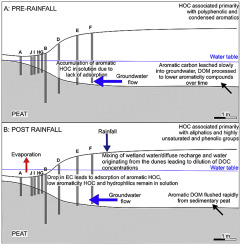当前位置:
X-MOL 学术
›
Water Res.
›
论文详情
Our official English website, www.x-mol.net, welcomes your feedback! (Note: you will need to create a separate account there.)
Changes in groundwater dissolved organic matter character in a coastal sand aquifer due to rainfall recharge.
Water Research ( IF 11.4 ) Pub Date : 2019-10-18 , DOI: 10.1016/j.watres.2019.115201 Liza K McDonough 1 , Denis M O'Carroll 2 , Karina Meredith 3 , Martin S Andersen 2 , Clément Brügger 4 , Hanxue Huang 2 , Helen Rutlidge 2 , Megan I Behnke 5 , Robert G M Spencer 5 , Amy McKenna 6 , Christopher E Marjo 7 , Phetdala Oudone 1 , Andy Baker 1
Water Research ( IF 11.4 ) Pub Date : 2019-10-18 , DOI: 10.1016/j.watres.2019.115201 Liza K McDonough 1 , Denis M O'Carroll 2 , Karina Meredith 3 , Martin S Andersen 2 , Clément Brügger 4 , Hanxue Huang 2 , Helen Rutlidge 2 , Megan I Behnke 5 , Robert G M Spencer 5 , Amy McKenna 6 , Christopher E Marjo 7 , Phetdala Oudone 1 , Andy Baker 1
Affiliation

|
Dissolved organic matter (DOM) in groundwater is fundamentally important with respect to biogeochemical reactions, global carbon cycling, heavy metal transport, water treatability and potability. One source of DOM to groundwater is from the transport of organic matter from the vadose zone by rainfall recharge. Changes in precipitation patterns associated with natural climate variability and climate change are expected to alter the load and character of organic matter released from these areas, which ultimately impacts on groundwater quality and DOM treatability. In order to investigate potential changes in groundwater DOM character after rainfall recharge, we sampled shallow groundwater from a coastal peat-rich sand aquifer in New South Wales, Australia, during an extended period of low precipitation (average daily precipitation rate < 1.6 mm day-1 over the 8 months prior to sampling), and after two heavy precipitation events (84 mm day-1 and 98 mm day-1 respectively). We assess changes in DOM composition after correcting for dilution by a novel combination of two advanced analytical techniques: liquid chromatography organic carbon detection (LC-OCD) and negative-ion electrospray ionization Fourier transform ion cyclotron resonance mass spectrometry (FT-ICR MS). We also assess changes in water chemistry pre- and post-rainfall. Post-rainfall, we show that the dilution-corrected amount of highly aromatic DOM molecular formulae (i.e. those categorised into the groups polyphenolics and condensed aromatics) were 1.7 and 2.0 times higher respectively than in pre-rainfall samples. We attribute this to the flushing of peat-derived DOM from buried organic material into the groundwater. We also identify that periods of low precipitation can lead to low hydrophilic/HOC ratios in groundwater (median = 4.9, n = 14). Redundancy analysis (RDA) was used to compare the HOC fraction with FT-ICR MS compound groups. We show that HOC has a more aromatic character in pre-rainfall samples, and is less similar to the aromatic groups in post-rainfall samples. This suggests that the decline in water-borne hydrophobics observed post-rainfall could be associated with preferential adsorption of the hydrophobic aromatic DOM, making post-rainfall samples less treatable for potable water supply. Post-rainfall we also observe significant increases in arsenic (leading to concentrations greater than 3 times the World Health Organisation drinking water limit of 10 μg / L). Increases in coastal rainfall due to climate change may therefore alter the composition of groundwater DOM in coastal peatland areas in ways that may impact DOM bioavailability, and increase arsenic concentrations, reducing the ease of water treatment for human consumption. To the best of our knowledge, this is the first study to identify the chemical and molecular changes of shallow groundwater DOM pre-rainfall and post-rainfall in a sedimentary organic carbon rich environment through multiple analytical techniques.
中文翻译:

降雨补给导致沿海砂质含水层中地下水溶解有机物特征的变化。
对于生物地球化学反应,全球碳循环,重金属运输,水可处理性和可饮用性而言,地下水中的溶解有机物(DOM)至关重要。地下水中DOM的一种来源是通过降雨补给从渗流带输送有机质。与自然气候多变性和气候变化相关的降水模式变化有望改变这些地区释放的有机物的负荷和特性,最终影响地下水质量和DOM的可处理性。为了研究降雨补给后地下水DOM特性的潜在变化,我们在一段长时间的低降水量(平均每日降水量<1)中对来自澳大利亚新南威尔士州沿海富泥炭的砂含水层的浅层地下水进行了采样。在采样前的8个月内,第1天6毫米),以及两次强降水事件之后(分别是第1天84毫米和第1天98毫米)。我们通过两种先进分析技术的新颖组合校正稀释后评估DOM组成的变化:液相色谱有机碳检测(LC-OCD)和负离子电喷雾电离傅里叶变换离子回旋共振质谱(FT-ICR MS)。我们还评估降雨前后的水化学变化。降雨后,我们显示高度芳香DOM分子式(即归类为多酚类和稠合芳香族的分子)经稀释校正后的量分别比降雨前样品高1.7倍和2.0倍。我们将此归因于泥炭来源的DOM从埋藏的有机材料冲入地下水。我们还发现低降水时期可能导致地下水中的亲水/ HOC比降低(中位数= 4.9,n = 14)。冗余分析(RDA)用于比较HOC分数与FT-ICR MS化合物组。我们显示,HOC在暴雨前的样品中具有更芳香的特征,而与暴雨后的样品中的芳族基团的相似性较低。这表明降雨后观察到的水性疏水性物质的减少可能与疏水性芳香族DOM的优先吸附有关,使得降雨后的样品难以用于饮用水供应。降雨后,我们还观察到砷显着增加(导致浓度超过世界卫生组织饮用水限值10μg/ L的3倍)。因此,由于气候变化而导致的沿海降雨增加可能会改变沿海泥炭地地区地下水DOM的组成,从而可能影响DOM的生物利用度,并增加砷的浓度,从而降低人们用水处理的难度。据我们所知,这是第一项通过多种分析技术确定富有机有机沉积环境中浅层地下水DOM暴雨前和暴雨后化学和分子变化的研究。
更新日期:2019-10-19
中文翻译:

降雨补给导致沿海砂质含水层中地下水溶解有机物特征的变化。
对于生物地球化学反应,全球碳循环,重金属运输,水可处理性和可饮用性而言,地下水中的溶解有机物(DOM)至关重要。地下水中DOM的一种来源是通过降雨补给从渗流带输送有机质。与自然气候多变性和气候变化相关的降水模式变化有望改变这些地区释放的有机物的负荷和特性,最终影响地下水质量和DOM的可处理性。为了研究降雨补给后地下水DOM特性的潜在变化,我们在一段长时间的低降水量(平均每日降水量<1)中对来自澳大利亚新南威尔士州沿海富泥炭的砂含水层的浅层地下水进行了采样。在采样前的8个月内,第1天6毫米),以及两次强降水事件之后(分别是第1天84毫米和第1天98毫米)。我们通过两种先进分析技术的新颖组合校正稀释后评估DOM组成的变化:液相色谱有机碳检测(LC-OCD)和负离子电喷雾电离傅里叶变换离子回旋共振质谱(FT-ICR MS)。我们还评估降雨前后的水化学变化。降雨后,我们显示高度芳香DOM分子式(即归类为多酚类和稠合芳香族的分子)经稀释校正后的量分别比降雨前样品高1.7倍和2.0倍。我们将此归因于泥炭来源的DOM从埋藏的有机材料冲入地下水。我们还发现低降水时期可能导致地下水中的亲水/ HOC比降低(中位数= 4.9,n = 14)。冗余分析(RDA)用于比较HOC分数与FT-ICR MS化合物组。我们显示,HOC在暴雨前的样品中具有更芳香的特征,而与暴雨后的样品中的芳族基团的相似性较低。这表明降雨后观察到的水性疏水性物质的减少可能与疏水性芳香族DOM的优先吸附有关,使得降雨后的样品难以用于饮用水供应。降雨后,我们还观察到砷显着增加(导致浓度超过世界卫生组织饮用水限值10μg/ L的3倍)。因此,由于气候变化而导致的沿海降雨增加可能会改变沿海泥炭地地区地下水DOM的组成,从而可能影响DOM的生物利用度,并增加砷的浓度,从而降低人们用水处理的难度。据我们所知,这是第一项通过多种分析技术确定富有机有机沉积环境中浅层地下水DOM暴雨前和暴雨后化学和分子变化的研究。














































 京公网安备 11010802027423号
京公网安备 11010802027423号